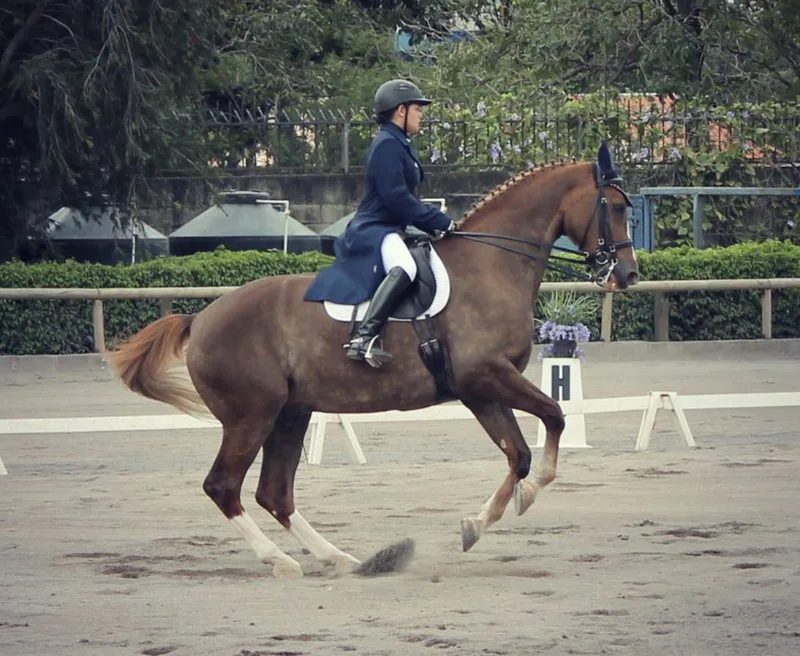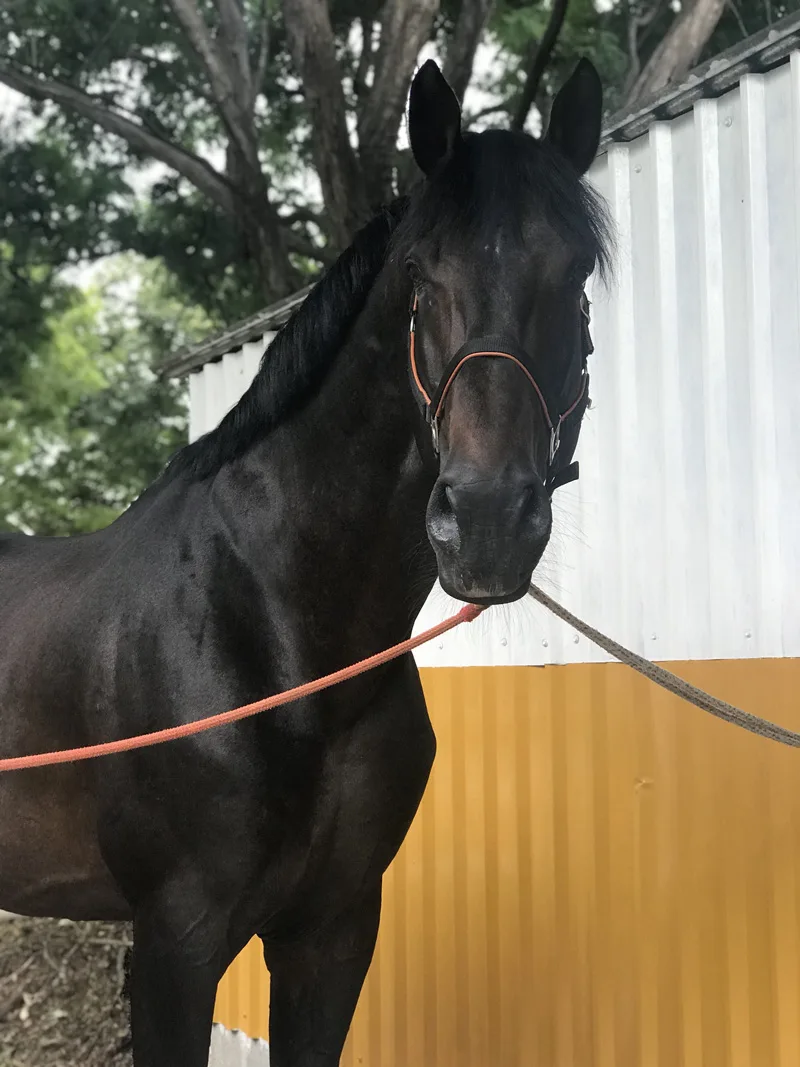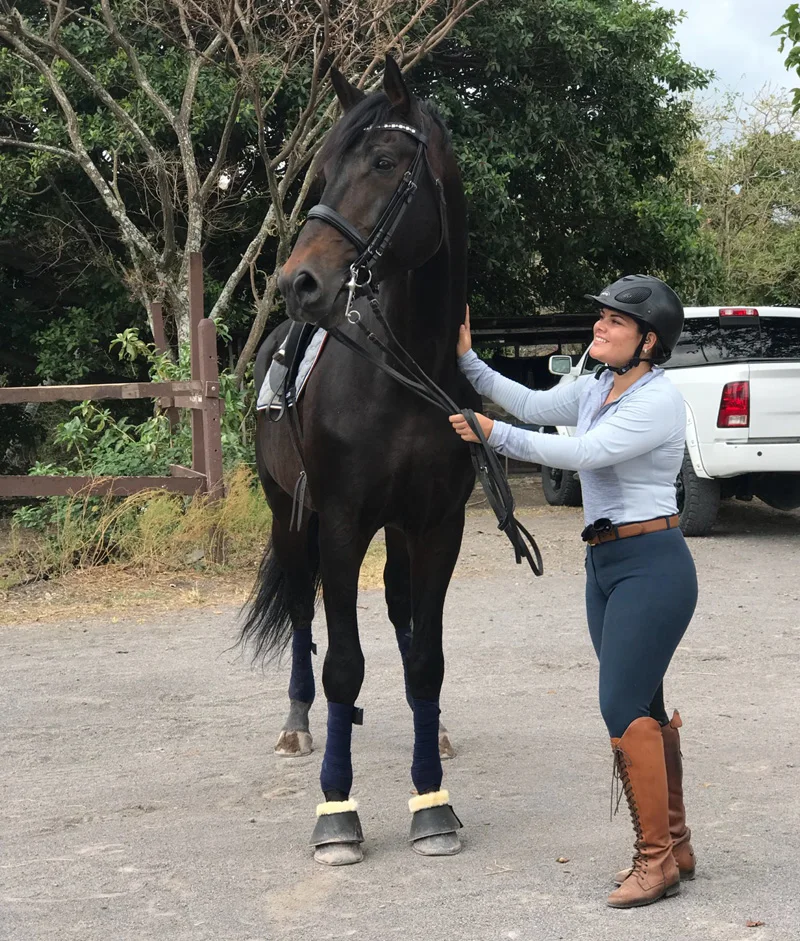When she was a child, Marice Rodriguez’s grandfather had a cattle farm in Guanacaste, Costa Rica, two hours outside of the capital city of San José. Rodriguez’s mother got her and her two younger siblings riding lessons in the city simply to make sure they wouldn’t get hurt riding the Quarter Horses used for sorting cattle on the farm.
“But I obviously escalated,” she said with a laugh.
Rodriguez’s riding journey took her to Wellington, Florida, back to Costa Rica, and from riding ranch horses to the 18-hand stallion she now owns and rides in the small Central American country, and it led her to a realization of what makes her happy in her riding.
Childhood riding dropped away until high school when Rodriguez got the bug again, and her mom, Virginia Aviles, signed her up for dressage because she didn’t want her to jump (to this day it’s mostly just poles on the ground).
Her first horse, Samurai, was “the most obnoxious, aggressive little thing,” but the Argentinian Warmblood was the only thing for sale at the time that could canter on both leads.
One time the horse kicked the mirrors in the dressage arena so hard the whole wall of mirrors shattered, costing $600 to replace. But in the show ring he turned into another animal, taking Rodriguez from training to first and then second level, never scoring less than 68 percent.
Determined to go all the way with her dressage, Rodriguez pleaded and begged for a Dutch Warmblood schoolmaster named Ruben that came up for sale—17 hands, socks on all four legs. After six months, her grandfather, Antonio Rodriguez, said, “I’m done listening to you,” and bought her the horse, who’d been imported from the Netherlands. “This is the only one; you can keep him until he dies of old age,” he told her.
Marice jumped from second level to the FEI Juniors tests, and then eight months later she was shortlisted for the 2013 Central American Games in Costa Rica.
After high school she went to Wellington, where she was a working student for Jennifer Benoit as well as Caroline Roffman while getting her college degree in business management and marketing at Palm Beach Atlantic University, bringing Ruben with her after her first couple months there.
After success in Costa Rica at the FEI level on a schoolmaster, it wasn’t an easy transition to go to Wellington, a mecca for dressage. “I ended up being a really good stall cleaner and learned more of horsemanship and riding in the couple of years I’d been there than what I’d learned all my life doing fancy dressage lessons,” she said.
“In general in the Latin American countries we tend to have a groom and just come and get on the horse,” she explained. “I’ve seen people show and compete who didn’t know how to put a bridle on—and I’m one of them!”
She said she would show up for her lessons in Costa Rica with a white shirt, pretty breeches and a carrot for the horse. “I put on my first bridle a month before leaving [for Wellington],” she admitted.
After her time as a working student though, Marice had honed her horsemanship.
Back in Costa Rica she was her own groom at the shows. “Why are you tacking up?” her friends would ask. “You are going to get dirty!”
ADVERTISEMENT
While she was in Florida, Roffman helped her sell Ruben, and Marice used the money to import a mare from Germany, Coco, an unbroken 3-year-old. Not long after getting Coco, she wrapped up her three years in South Florida when her parents reminded her that while her Wellington experience was nice, it was time to come home.
The transition back to Costa Rica, getting a job and riding was tough. “I thought I’d came back and be a pro, and everyone would love me,” she said. She took a year to do an internship in her father’s office and figure out what to do as her plans to be a trainer were falling flat.
“Here it’s all about the levels you ride at,” she said of the small Costa Rican dressage world. “I couldn’t even say, ‘I’m an FEI rider. Come take lessons.’ ”
While the shows get good judges, there are about five or six national shows a year and only one FEI-affiliated one. Most shows have about 30 to 40 competitors total.
On Marice’s return from Florida, she went from riding with top trainers in Florida to having a naughty young horse and not really having a job. Even worse, she realized she didn’t like an office job. “I was just back from three years of toting hay bales and feeding and running around the barn. Sitting in an office wasn’t for me,” she said.
And Coco had become big, strong and marish. She was gorgeous and talented but too much horse. “She was the most talented horse I ever had, but I was falling off,” Marice said.
“I always wind up with gigantic horses,” Marice joked. She’s 5’4″, and Coco had become a very muscular 17.1 hands by the age of 4.
“When I bought her, she was 16 hands. I was like, great! I didn’t take into account she was 3,” she explained.
Marice needed a break. She needed to tell her parents she didn’t want an office job, and she needed to figure out what to do with Coco. She found a rider for the horse, and her father suggested she work at her grandfather’s cattle ranch, El Escudo, “the field,” so called because when her grandfather bid on the farm, he won it on a coin toss. Heads or tails, escudo o corona. Her grandfather had died in 2012, shortly before she left for Wellington.
The farm has about 1,300 head of cattle on a total of about 1,300 hectares of land, and they breed Brahman and Nelore cattle commercially and for the show ring. The farm was extremely successful under her grandfather.
She began to work at the farm in early 2017, spending Mondays through Thursdays there and then riding Coco when she was back in the city. Coco, like Samurai, was great at shows and was soon competing up to third level, but Marice realized she was scared. She remembered riding horses in Florida who could be naughty, and it hadn’t bothered her. But this mare was taking her away confidence.
She enjoyed her job at El Escudo, building on her grandfather’s legacy, and she realized she could become an amateur and find a horse she could have fun on. She had taken on a lot with developing new feeding regimes and breeding the genetic lines left by her grandfather and day-to-day farm operations.
She loved Coco, but she also realized it was probably no nicer for the mare than it was for her to be scared, so she put her up for sale. Coco quickly sold to a young rider, Antonio Maklouf, and the mare wound up going back to Wellington.
Marice also had to work through her expectations of what would happen now that she was not in Wellington and not on the path to becoming a professional in Costa Rica. She’d seen her peers drift away from riding after deciding not to go pro.
ADVERTISEMENT
While Coco had sold for a good price, Marice invested money into the cattle farm and had a budget, and that meant it wasn’t easy to find what she was looking for, especially with the cost of importing a horse to Costa Rica. She was hoping to find a horse that had changes and went in a double bridle, so she could continue her dressage education.
Marice found a 2016 video of a horse from a dealer in Belgium. It was an 11-year-old 18-hand stallion. It didn’t seem like a great idea to get a stallion, and he was out of her budget, but he had all the things Marice was looking for.
The horse, Farro des Famennes (Warkant Van’t Gesterlhof—Hokely Du Moulin, Ulak Di Chateau), had shown up to Intermediaire I, had piaffe and passage, and was getting 70s on the small tour.
At this point “Farro,” a Belgian Warmblood and approved stallion, was 12. His French owners weren’t interested in having him gelded, and he was really big. They just wanted him to have a good home.
Marice added a little more to her budget and in a leap of faith bought Farro off the video. She built a small barn for him at the farm, since that’s where she was spending her time, with a huge stall, wash rack and an arena.
“The stallion is the most amazing horse I’ve ever met,” she said of Farro, whom she calls Big Bear. “He’s just as they described, so mellow.”
Going full circle, Maklouf, the young rider who bought Coco, gives Marice “eyes on the ground” when she brings him to San José for the day once a month, making time for her as he trains and attends medical school.
Marice has plans to get back into the show ring, starting off at third level with the big horse. Travel however is not easy in Costa Rica. A trip to a show might take 2.5 hours as the roads are often not well paved and not a smooth ride for the horses.
But thanks to Farro she’s back to the point where she loves riding. “I get up, and I can’t wait to get on my stallion,” she said. “I finally found my way.
“He’s magic,” she added. “I always wished I had a black stallion. He’s a horse you can put anywhere, tack him up, and he’s the same horse.”
And in addition to helping with her riding fears, Farro has alleviated her worries of what would happen to her riding as an amateur.
“Mixing your life as different as it is [with work and other stressors] and trying to squeeze in the time; it can be done when you have a horse as wonderful as Farro,” she said. “I didn’t continue with my equestrian career as planned, but I’m enjoying it. It’s not about the ribbons; it’s about doing what you love.”



















